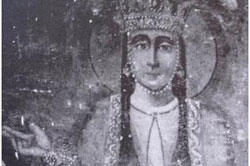
Hyderabad: Modern science has helped solve a long-standing puzzle in history.
Studies, based on analysis of deoxyribonucleic acid (DNA), have helped confirm that the relic in the St Augustine's Church in Goa is likely that of the Queen of Georgia, Ketevan.
A team of investigators from Hyderabad-based Centre for Cellular and Molecular Biology (CCMB), Archeological Survey of India and Estonian BioCentre led by K. Thangaraj of CCMB has traced that the relic excavated from the Church complex in Goa, could belong to the Georgian Queen Ketevan.
This first ancient DNA study from South Asia has been published online in journal Mitochondrion.
Queen Ketevan was born in 1565 to a royal family of Georgia (Eastern Europe). In the Medieval period, the Georgian kingdom was a vassal (subordinate) kingdom and a bone of contention between two mighty empires in west Asia; the Ottoman Turks and the Safavids in Persia (now Iran).
It was during this period when entire Persia and its surrounding region was under control of the emperor Shah Abbas I (1587-1629), who was contemporary to Mughal Emperor Jalaluddin Akbar in India that the former led an army to conquer the Georgian kingdom and took Queen Ketevan as prisoner.
For about a decade (1614 to 1624) the Queen remained in Shiraz as prisoner. In 1624, the Persian Emperor attempted to convert the Queen to Islamic faith. Resisting his wishes, Queen Ketevan was tortured and finally strangled to death on September 22, 1624.
As per literary evidences, available in Portuguese, it was believed that in 1627 her right arm bone was brought to Goa by an Augustinian Friar (saint) and kept in a black box (stone sarcophagus) on the second window along on the Epistle side of the chapel within the St. Augustine's convent at old Goa.
For almost 400 years, the remains of Georgian Queen Ketevan laid undisturbed somewhere in the St. Augustine's convent.
The Georgian Government approached India to search for the relic. Since 1989, various delegations from Georgia visited India and have worked together with the Archaeological Survey of India (ASI) and tried to locate Queen Ketevan's grave within the ruins of the Goan convent.
“Excavations by archeologists of the ASI, Goa-circle, assisted by a Portuguese exchange student in May 2004 led to the identification of the bone relic, but the evidence could not be considered conclusive, therefore we approached CCMB, Hyderabad for ancient DNA study”, said Nizamuddin Taher, Archeological Survey of India.
“We developed our own methods for DNA extraction from ancient bone samples and successfully analysed the sample” said Niraj Rai, Ph.D student of CCMB and one of the members of this team.
CCMB scientists have isolated DNA from the bone and sequenced selected region of the mitochondrial DNA. Detailed analysis of select Georgians suggested similar DNA traces pointing that the bone excavated in Goa is likely to be the remnant of Queen Ketevan of Georgia”, said Thangaraj.